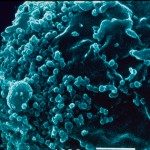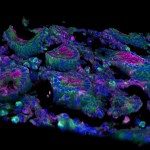Link to Pubmed [PMID] – 10225231
J Acquir Immune Defic Syndr Hum Retrovirol 1999 Apr; 20(5): 481-7
To investigate the genetic and biologic features of HIV-1 strains circulating in Cambodia, viruses from 95 HIV-1-seropositive individuals were subtyped by heteroduplex mobility assay (HMA) and 23 were further analyzed for their biologic characteristics. Eighty-nine individuals were clearly infected by HIV-1 subtype E. The other six samples were sequenced, together with 17 HMA subtype E samples. All but one of the 23 Cambodian env sequences clustered with previously described Thai and Vietnamese subtype E sequences, bearing a GPGQ motif at the tip of the V3 loop; the last had a GPGR motif and was phylogenetically equidistant from Asian and African subtype E viruses. Nonsyncytium-inducing, CCR5-dependent viruses predominated in patients of clinical stage B even in some with a high viral load and were detected in about 50% of the patients of stage C. All syncytium-inducing strains, mostly from AIDS patients, used both CCR5 and CXCR4. The presence of syncytium-inducing viruses did not correlate with the plasma viral load. These data show that CCR5-dependent HIV-1 subtype E is currently predominant in Cambodia. The analysis of clinical and virologic markers strongly supports the idea that dynamics of the viral population during subtype E infection in Southeast Asia is similar to that of subtype B infection in Europe and the United States.The National AIDS Control and Prevention Program of the Cambodian ministry of health has reported that the prevalence of HIV-1 infection among blood donors in Cambodia increased from less than 1% in 1991 to 4% in 1996, and that 39.3% of prostitutes, 7.1% of military personnel, 3.2% of pregnant women, and 5.2% of tuberculosis patients were infected in 1997. Findings are presented from an investigation of the genetic and biological features of HIV-1 strains in Cambodia. Viruses from 95 HIV-1-seropositive individuals were subtyped by heteroduplex mobility assay (HMA) and 23 were further analyzed for their biologic characteristics. 89 people were clearly infected with HIV-1 subtype E. The other 6 samples, however, were sequenced together with 17 HMA subtype E samples. All but 1 of these latter 23 Cambodian env sequences clustered with previously described Thai and Vietnamese subtype E sequences bearing a GPGQ motif at the tip of the V3 loop, with the last having a GPGR motif and being phylogenetically equidistant from Asian and African subtype E viruses. Nonsyncytium-inducing, CCR5-dependent viruses predominated in patients of clinical stage B, and were detected in about half of the stage C patients. All syncytium-inducing strains, mostly from AIDS patients, used both CCR5 and CXCR4. The presence of syncytium-inducing viruses did not correlate with the plasma viral load. These data show that CCR5-dependent HIV-1 subtype E currently predominates in Cambodia. The dynamics of the viral population during subtype E infection in Southeast Asia appear to be similar to that of subtype B infection in Europe and the US.



